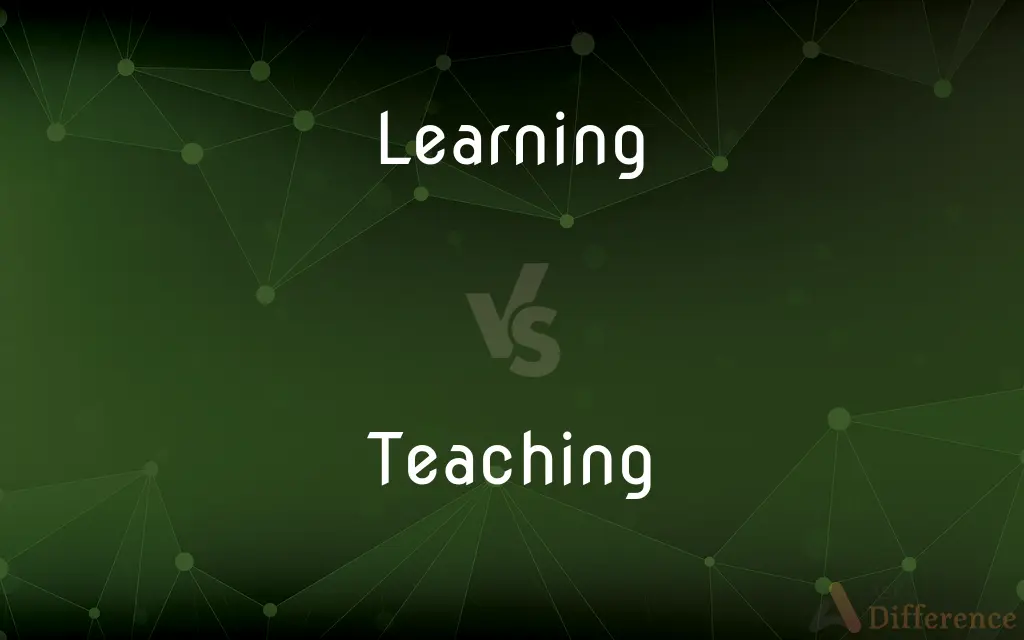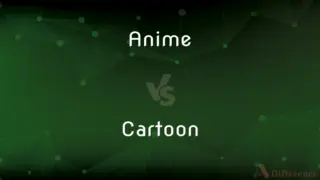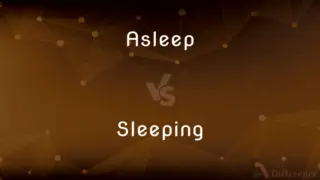Learning vs. Teaching — What's the Difference?
By Tayyaba Rehman — Updated on October 5, 2023
"Learning" implies acquiring knowledge or skills, while "Teaching" involves imparting knowledge or instructing someone in learning something new.

Difference Between Learning and Teaching
Table of Contents
ADVERTISEMENT
Key Differences
Learning" and "Teaching" are inherently linked concepts that denote different aspects of the educational process. Learning is a personal and internal process, involving the acquisition and assimilation of new information and skills by the learner. In contrast, teaching serves as an external facilitation of this process, guiding the learner toward understanding and knowledge acquisition through structured instruction and sharing of information.
When we focus on the aspect of interaction, "Learning" can occur independently, without the need for another individual, as one may learn through reading, observing, or practicing a skill autonomously. On the other hand, "Teaching" inherently involves at least two entities: the teacher who imparts knowledge, and the learner who receives it, thus illustrating the interactive nature of teaching as opposed to the potentially solitary nature of learning.
Addressing effectiveness, "Learning" and "Teaching" may both occur without the other being effective. A person might be engaged in learning but not assimilate the knowledge if the method or content is not suitable. Similarly, teaching can occur, but if the individual does not grasp or retain the provided knowledge, effective learning has not transpired, showcasing that the presence of teaching does not always guarantee learning, and learning can happen without deliberate teaching.
With regard to adaptability, "Learning" is often considered more adaptive as it encompasses any activity or experience that results in a gain in knowledge or skill, whether intentional or incidental. "Teaching" typically implies a level of intentionality and structure, involving planned activities, methods, and objectives, thus reflecting a more formal and structured endeavor in comparison to the potentially informal and varied nature of learning.
Concerning evolution, both "Learning" and "Teaching" have undergone notable changes with advancements in technology and pedagogy. Learning has expanded beyond traditional methods to include e-learning, utilizing various technological tools and platforms. Conversely, teaching has evolved to incorporate diverse methods and approaches, such as flipped classrooms and online instruction, demonstrating the dynamic and evolving nature of both concepts in contemporary education.
ADVERTISEMENT
Comparison Chart
Definition
The process of acquiring knowledge or skills.
The act of imparting knowledge or skills.
Interactivity
Can be solitary or collaborative.
Involves at least two parties: teacher and learner
Effectiveness
May occur without teaching.
Does not guarantee learning.
Adaptability
Can be informal and incidental.
Typically involves structured, intentional actions.
Evolution with technology
Encompasses e-learning and self-guided study via tech.
Incorporates varied methods, including online instruction.
Compare with Definitions
Learning
"Learning" might involve personal development and growth.
Her learning journey involved understanding her own strengths and weaknesses.
Teaching
"Teaching" involves imparting knowledge or skills to others.
Her teaching method involved a lot of hands-on activities.
Learning
"Learning" encompasses mental and physical adaptation.
The learning of adaptive strategies is vital in evolutionary biology.
Teaching
"Teaching" includes facilitating and guiding learning processes.
His teaching always aimed to empower students in their learning.
Learning
"Learning" can denote studying in an educational context.
His learning was primarily through online courses.
Teaching
"Teaching" may involve mentoring and coaching.
His teaching extended beyond the classroom into life skills and mentorship.
Learning
"Learning" involves acquiring new knowledge or skills.
Learning a new language can be both challenging and rewarding.
Teaching
"Teaching" can denote the profession of educators.
Her teaching took her to various schools around the country.
Learning
Learning is the process of acquiring new understanding, knowledge, behaviors, skills, values, attitudes, and preferences. The ability to learn is possessed by humans, animals, and some machines; there is also evidence for some kind of learning in certain plants.
Teaching
"Teaching" might imply providing specific instructions.
Teaching someone to drive requires patience and clear instructions.
Learning
The acquisition of knowledge or skills through study, experience, or being taught
An important learning process
These children experienced difficulties in learning
Teaching
The act, practice, occupation, or profession of a teacher.
Learning
The act, process, or experience of gaining knowledge or skill.
Teaching
Something taught.
Learning
Knowledge or skill gained through schooling or study.
Teaching
Often teachings A precept or doctrine
The teachings of Buddha.
Learning
(Psychology) Changes in behavior resulting from experience, especially changes due to conditioning.
Teaching
Of, involving, or used for teaching
Teaching materials.
Teaching methods.
Learning
(uncountable) An act in which something is learned.
Teaching
Working as a teacher or in teaching
Teaching assistants.
Learning
(uncountable) Accumulated knowledge.
The department head was also a scholar of great learning.
Teaching
Something taught by a religious or philosophical authority.
Many follow the teachings of Confucius.
Learning
(countable) Something that has been learned
Teaching
The profession of educating people; the activity that a teacher does when he/she teaches.
Teaching has seen continual changes over the past decades.
I have found a teaching job.
A teaching assistant
Learning
Present participle of learn
I'm learning to ride a unicycle.
Teaching
Present participle of teach
Learning
The acquisition of knowledge or skill; as, the learning of languages; the learning of telegraphy.
Teaching
The act or business of instructing; also, that which is taught; instruction.
Learning
The knowledge or skill received by instruction or study; acquired knowledge or ideas in any branch of science or literature; erudition; literature; science; as, he is a man of great learning.
Teaching
The profession of a teacher;
He prepared for teaching while still in college
Pedagogy is recognized as an important profession
Learning
The cognitive process of acquiring skill or knowledge;
The child's acquisition of language
Teaching
A doctrine that is taught;
The teachings of religion
He believed all the Christian precepts
Learning
Profound scholarly knowledge
Teaching
The activities of educating or instructing or teaching; activities that impart knowledge or skill;
He received no formal education
Our instruction was carefully programmed
Good teaching is seldom rewarded
Learning
"Learning" may also imply becoming aware or informed.
She was learning of the recent developments in the news.
Common Curiosities
How does technology impact learning and teaching?
Technology expands access and formats for learning and provides diverse tools and platforms for teaching.
Is learning always a result of teaching?
No, learning can occur without teaching through experiences, observation, and self-study.
What role does motivation play in learning and teaching?
Motivation significantly impacts learning by driving engagement and focus, while in teaching, it enhances the instructor's effectiveness and enthusiasm.
Is formal education the only way of learning and teaching?
No, informal and non-formal education also facilitate learning and teaching through various platforms and contexts outside traditional schooling.
Can teaching occur without learning?
Yes, teaching can occur without learning if the information or skills are not effectively assimilated by the learner.
What are different styles of learning and teaching?
There are various styles, including visual, auditory, and kinesthetic learning, and teaching styles like authoritative, facilitative, and demonstrative.
Can learning and teaching occur simultaneously?
Yes, reciprocal teaching and peer learning are examples where learning and teaching can happen concurrently.
How do personal learning styles affect the effectiveness of teaching strategies?
Personal learning styles influence how individuals absorb and process information, thus teaching strategies must be diversified to cater to varied learning preferences.
How do cultural differences impact learning and teaching?
Cultural differences can influence learning preferences, communication styles, and relational dynamics, which must be considered in teaching strategies to ensure inclusivity and effectiveness.
Can experiential learning be a form of teaching?
Yes, experiential learning, where learning occurs through experiences and reflection, can also serve as a teaching method by facilitating hands-on and real-world learning environments.
How can technology be integrated into teaching and learning effectively?
Effective integration involves ensuring accessibility, utilizing platforms that enhance instructional delivery, and employing tools that engage learners and support their educational needs.
How can educators ensure inclusivity in learning and teaching environments?
Ensuring inclusivity involves recognizing and valuing diversity, adapting teaching strategies to cater to varied needs, and creating an environment where all learners feel seen and valued.
What are some challenges faced by online learning and teaching?
Challenges may include technological barriers, maintaining engagement, ensuring accessibility, and adapting traditional teaching strategies to virtual formats.
How does assessment play a role in learning and teaching?
Assessment in learning helps gauge understanding and recall, while in teaching, it provides feedback on instructional effectiveness and guides future strategies.
What is the role of feedback in learning and teaching?
Feedback in learning aids in recognizing areas for improvement and validating understanding, while in teaching, it helps refine instructional strategies and enhance educator effectiveness.
Share Your Discovery

Previous Comparison
Anime vs. Cartoon
Next Comparison
Asleep vs. SleepingAuthor Spotlight
Written by
Tayyaba RehmanTayyaba Rehman is a distinguished writer, currently serving as a primary contributor to askdifference.com. As a researcher in semantics and etymology, Tayyaba's passion for the complexity of languages and their distinctions has found a perfect home on the platform. Tayyaba delves into the intricacies of language, distinguishing between commonly confused words and phrases, thereby providing clarity for readers worldwide.
















































